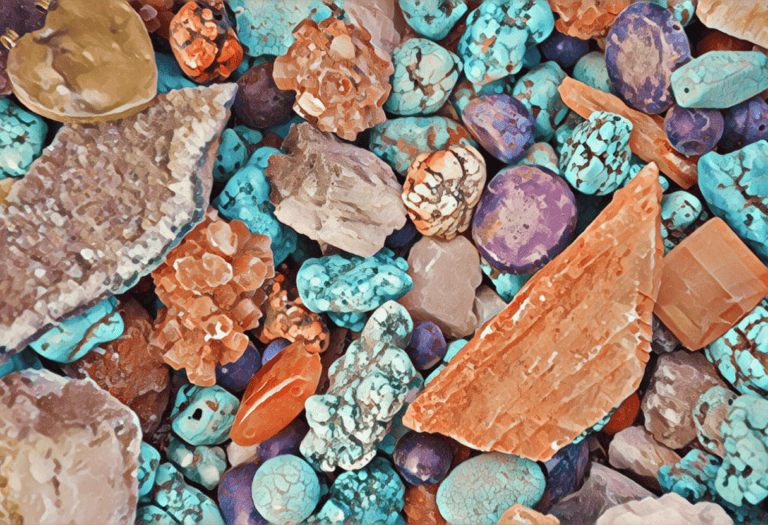Identifying sugilite, a rare purple gemstone, can be thrilling.
You’re about to dive into the vibrant world of a stone cherished for its unique color and metaphysical properties.
Whether you’re a collector, a jewelry enthusiast, or simply curious, knowing how to spot genuine sugilite is crucial.
Spot real sugilite: purple (pink-deep), opaque/translucent, white streak, non-magnetic, 5.5-6.5 hardness, single refraction. Found in manganese-rich areas. Use hammer, gloves, loupe, backpack, GPS. Prioritize safety: gear, awareness, hydration, communication, first aid. Clean gently, store individually, avoid sunlight. Enjoy unique beauty!
How to Identify Sugilite Through Testing
When you come across a stone you think might be sugilite, it’s essential to perform several tests to confirm its identity. These tests range from simple observations to more detailed examinations that might require equipment.
Visual Inspection
Start with a thorough visual inspection under good light. Genuine sugilite exhibits a range of purple shades, from pale lilac to deep violet. Look for characteristic inclusions or patterns such as mottling, swirling, or banding. Sugilite’s translucency can vary, but it’s generally opaque to translucent. Uniform color and excessive clarity might signal synthetic or imitation gemstones.
The Streak Test
The streak test is straightforward: scrape the stone against unglazed porcelain and observe the color of the streak it leaves. Sugilite will typically leave a white or light-colored streak, confirming its authenticity. A different color could indicate a different mineral.
Magnet Test
Performing a magnet test can be revealing. Genuine sugilite is not magnetic, so if your sample is attracted to a magnet, you’re likely dealing with a counterfeit or a mixed composition stone.
Hardness Test
Using the Mohs scale to determine hardness is a classic method. Sugilite has a hardness rating of 5.5 to 6.5. You can test this by trying to scratch the surface with a substance of known hardness. If it scratches easily, it might not be real sugilite.
Birefringence Test
The birefringence test involves examining the gem through a polariscope to check for double refraction. As sugilite is isotropic, it shouldn’t show birefringence. Observable birefringence would suggest a different mineral.
Checking The Diaphaneity
Look at the stone’s transparency or opaqueness—sugilite’s diaphaneity. Holding the gem against a light source helps you determine if it’s transparent, translucent, or opaque. Sugilite’s characteristic translucency should be apparent.
Single or Double Refraction
Sugilite uniquely exhibits single refraction due to its isotropic nature. By contrasting it with stones that show double refraction, you can often make a clear distinction.
Refractive Index Test
The refractive index (RI) is crucial in identifying sugilite. Professional gemologists use a refractometer to measure RI. Sugilite’s RI usually ranges between 1.607 and 1.610. Outliers suggest it’s not genuine.
Finding The Specific Gravity
The specific gravity of sugilite floats around 2.74 to 2.80. Testing for specific gravity involves measuring the stone’s weight in air compared to its weight in water. A discrepancy from this range could indicate a false stone.
Identifying Sugilites in the Field
In the field, identifying sugilite might involve recognizing host rocks or usual geological settings. Knowing sugilite is primarily found in manganese-rich environments can guide your search.
Recognizing Potential Sugilite Rocks
Potential sugilite rocks may have unique textures or colors that hint at their precious content. Look for those telltale deep purple hues, and remember that rough sugilite may appear less vibrant until polished. Keep an eye out for the signs and trust your testing to make a definitive identification.
Physical Characteristics of Sugilite

When you’re out in the field or examining a gemstone collection, understanding the physical characteristics of sugilites can greatly aid in their identification. Recognize sugilite by its colors which can range from a light pink to a deep purple. Often, it exhibits a vibrant lavender to purple hue that’s particularly sought after.
The gemstone typically possesses a waxy to vitreous luster, giving it a distinct shine that sets it apart from other minerals. Its translucency ranges from opaque to translucent. Sugilite’s striking appearance can also be characterized by its texture. You’ll find that it has a uniform texture devoid of any visible crystal structures.
Here’s a quick guide to the physical properties you should be aware of:
- Color: Pink to purple
- Luster: Waxy to vitreous
- Diaphaneity: Opaque to translucent
- Texture: Uniform and non-crystalline
Another way to identify sugilite is by its hardness. Measuring between 5.5 to 6.5 on the Mohs scale, sugilite is relatively hard, making it resistant to scratches from softer substances. Always remember to handle sugilite with care to avoid accidental damage when performing a hardness test.
Keep in mind that sugilite’s specific gravity falls around 2.74 to 2.80, which is a key identifier since it will feel heavier than minerals of a similar size with a lower specific gravity. This data is particularly useful if you’re comparing a suspect sugilite with other violet minerals.
| Property | Measurement |
|---|---|
| Hardness | 5.5 to 6.5 |
| Specific Gravity | 2.74 to 2.80 |
By combining these physical characteristics with the tests mentioned earlier, you’ll significantly increase your chances of accurately identifying sugilite.
How Are Sugilite Formed?
Sugilite is an intriguing mineral born deep within the Earth’s crust under specific conditions that favor its creation. It forms primarily through syngenetic and epigenetic processes. During its formation, lithium-rich pegmatites and manganese-bearing metamorphic rock layers undergo chemical changes, giving rise to sugilite’s unique composition.
Syngenetic Formation
In syngenetic formation, sugilite crystallizes simultaneously as the surrounding host rocks. This process occurs when hydrothermal fluids, rich in elements like lithium, aluminum, and manganese, interact with the existing rock formations. The cooling of these fluids leads to the precipitation of sugilite crystals.
- The temperature of formation is typically around 300 to 500 degrees Celsius.
- The fluid’s composition plays a critical role in the mineral’s coloration and purity.
Epigenetic Formation
Alternatively, sugilite can form epigenetically, meaning it develops later than the surrounding rocks due to changes in the geochemical environment. In these scenarios, manganese-rich fluids infiltrate pre-existing rocks, depositing sugilite in cavities and fractures.
- Fluid movement is driven by tectonic activity, which can alter the pressure and temperature conditions.
- The mineral may fill in pre-existing fractures, resulting in vein-like structures.
By understanding these geological processes, you gain insight into the conditions that contribute to the formation of sugilite, enhancing your ability to recognize the gemstone in its rough state. Keep in mind that the size and quality of sugilite deposits can vary significantly due to these naturally occurring variables.
Preparation for Sugilite Hunting
As you gear up for your sugilite hunting adventure, it’s imperative to have the right tools on hand. Not only will they make your search more efficient, but they’ll also ensure that you can properly handle and identify any sugilite you come across.
Gathering the Right Tools
Before heading out, make sure you’re equipped with:
- Geologist’s hammer: Essential for gently breaking open rocks to reveal any potential sugilite.
- Chisel and gloves: For safely prying apart rocks and protecting your hands.
- Magnifying glass or jeweler’s loupe: These are key for a closer inspection of mineral qualities.
- Field guide: Carry a guide with images and descriptions of sugilite to verify your finds.
- Sturdy backpack: To comfortably transport your tools and any sugilite specimens you uncover.
- GPS device or map: Ensure you can navigate to sugilite-rich areas and back.
Having these tools organized and ready to go will streamline your search process, allowing you to focus on identifying and collecting high-quality sugilite specimens.
Safety Considerations
Sugilite hunting can be thrilling, but safety should always be your top priority. Here are essential safety tips to keep in mind:
- Wear protective gear: Essential items include safety glasses, durable gloves, and steel-toe boots to prevent injuries.
- Stay aware of your surroundings: Watch out for falling rocks, steep slopes, and wildlife.
- Keep hydrated and protected from the elements: Drink plenty of water, and use sunscreen and hats to protect against sunburn.
- Inform someone of your plans: It’s crucial that someone knows where you are and when you plan to return.
- Be cautious with tools: Use your hammer and chisel with care to avoid accidents.
By following these guidelines, you’ll be better equipped to safely enjoy the hunt for this captivating mineral, ensuring a rewarding and memorable experience in the field.
Handling and Care of Found Sugilite

Once you’ve triumphed in your hunt and have sugilite specimens in hand, proper care is paramount to preserve their natural beauty and value. These vibrant stones warrant gentle handling and specialized care routines.
Cleaning Sugilites
Your newly found sugilites might be coated in dirt or other natural materials. Cleaning them properly is essential to avoid damaging their structure or coloration.
- Rinse Gently: Begin by rinsing your sugilites under lukewarm water. This method eliminates loose debris without compromising the stone’s integrity.
- Soft Brushing: Use a soft-bristled brush, such as a toothbrush, to softly scrub the stone’s surface. It’s crucial to avoid abrasive materials that can scratch.
- Mild Soap: If needed, incorporate a mild soap—preferably one free of dyes and scents—to help dissolve stubborn grime.
- Air Drying: After rinsing off any soap, let your sugilites air dry or use a soft lint-free cloth to pat them dry gently.
Avoid soaking sugilites in water or using harsh chemicals, as prolonged exposure can damage them.
Storing Sugilites
Proper storage is as critical as the initial cleaning. Keep your sugilites in prime condition by following these storage guidelines:
- Individual Wrapping: Wrap each sugilite separately in a soft cloth or place them in padded boxes. This prevents stones from scratching each other.
- Controlled Environment: Store them in a cool, dry place away from direct sunlight, which can fade their rich color over time.
- Separation from Harder Stones: Keep sugilites away from jewels or stones of higher Mohs hardness to prevent unwanted scratches or chips.
- Regular Inspection: Periodically check on your stored sugilites for any signs of damage or deterioration.
By observing these practices, you’ll ensure that your sugilites retain their splendor and structural integrity for years to come.
Conclusion: Confirming Sugilite is Real
You now have the knowledge to confidently identify sugilite and ensure its longevity.
Remember to handle your gem with care, clean it delicately, and store it properly to maintain its vibrant hues and luster. Regular inspections will help catch any signs of wear or damage early on, safeguarding your sugilite’s splendor.
Cherish your unique find and enjoy the rich color and energy it adds to your collection.



![West Virginia Rockhounding Sites in [year]](https://observationhobbies.com/wp-content/uploads/2024/01/761QOgtzpwvHOJxQkXwdF-768x439.jpg)



